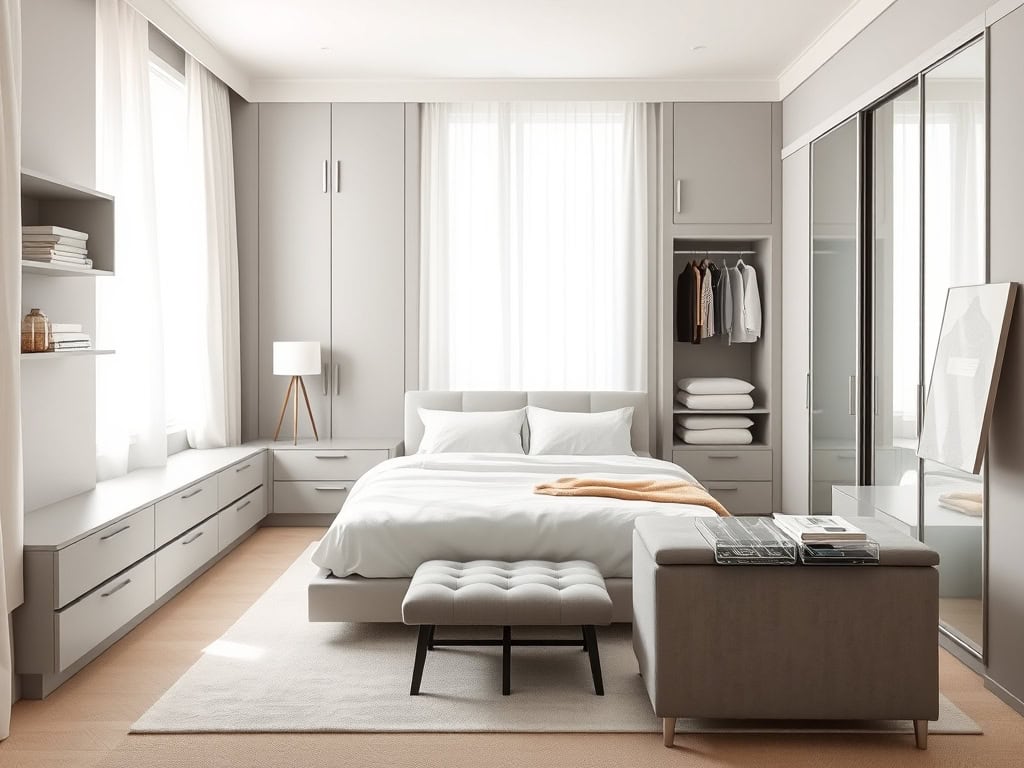If you’re struggling with a small master bedroom, you’re not alone! I’ve dealt with the same storage headaches in my 12×14 space, but there’s hope for maximizing every square inch. From genius under-bed solutions that can triple your storage to multi-purpose furniture that works overtime, these eight clever ideas will transform your cramped bedroom into an organized oasis. Let me show you how to make the most of what you’ve got, starting with my favorite space-saving hack.
Under-Bed Storage Solutions
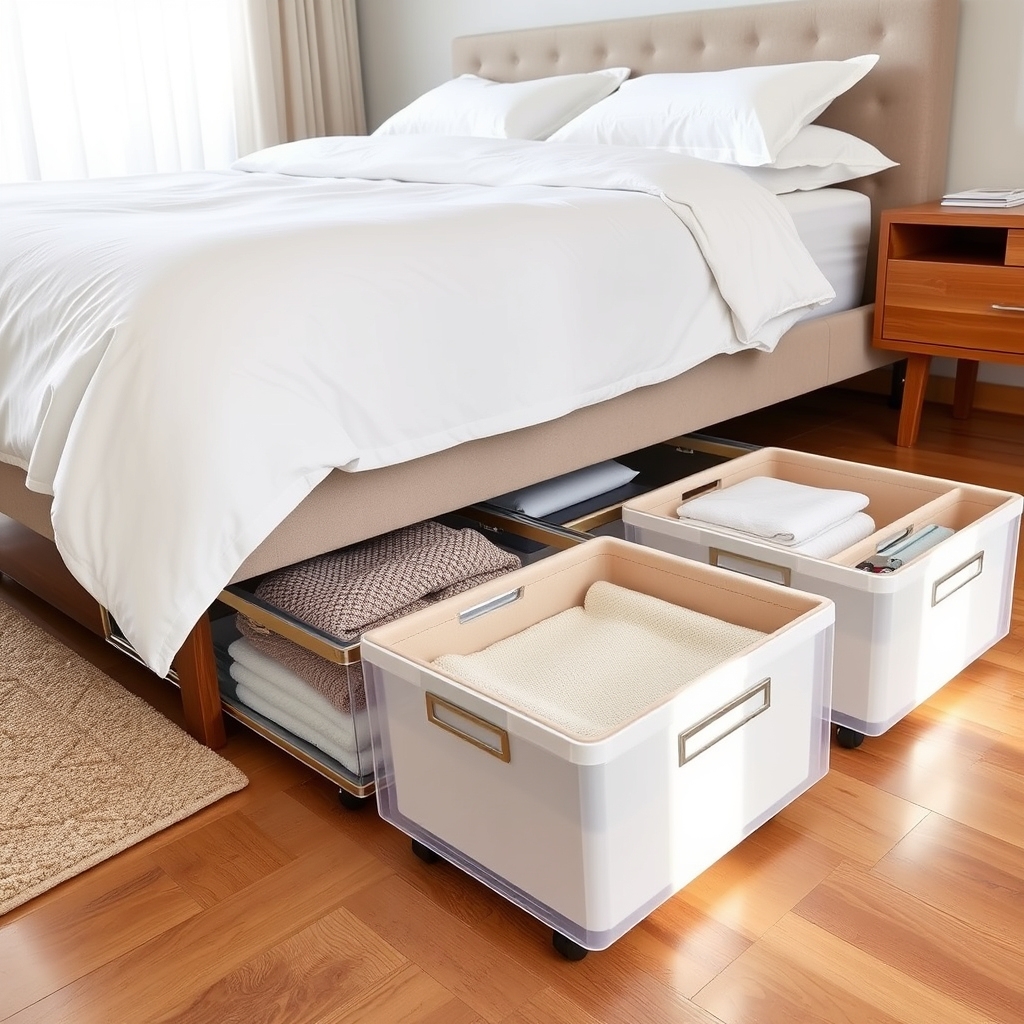
Making use of under-bed space is one of the most effective ways to maximize storage in any bedroom. This often-overlooked area can provide substantial storage capacity, equivalent to several dresser drawers, without taking up additional floor space or compromising the room’s aesthetic appeal.
Proper under-bed storage organization not only helps declutter your living space but also protects stored items from dust and damage. When implemented correctly, this storage solution offers easy access to seasonal items, extra bedding, clothing, or other belongings while keeping them hidden from view.
Required Items:
- Under-bed storage containers or drawers
- Bed risers (if needed)
- Measuring tape
- Labels
- Vacuum storage bags
- Anti-dust covers
- Drawer dividers
- Clear plastic bins
- Rolling casters (optional)
Start by measuring the available space under your bed, including height, width, and depth. Clear the area completely and vacuum thoroughly. If additional height is needed, install bed risers.
Select storage containers that maximize the available space while allowing for easy sliding in and out. Use vacuum storage bags for soft items like extra bedding or seasonal clothing to minimize bulk.
Group similar items together and place them in designated containers. Position frequently accessed items toward the front for convenience. Install wheels on larger containers if the floor surface allows for smooth movement. Label each container clearly on both the end and top for easy identification without pulling everything out.
Additional Tips:
Create a detailed inventory of stored items and their locations to avoid unnecessary searching. Consider using clear containers for better visibility or adding small handles for easier access.
Place cedar blocks or lavender sachets in containers storing fabric items to maintain freshness and deter pests. Rotate seasonal items twice yearly to ensure nothing gets forgotten, and regularly assess stored items to prevent accumulation of unnecessary belongings.
Vertical Wall Organization Systems
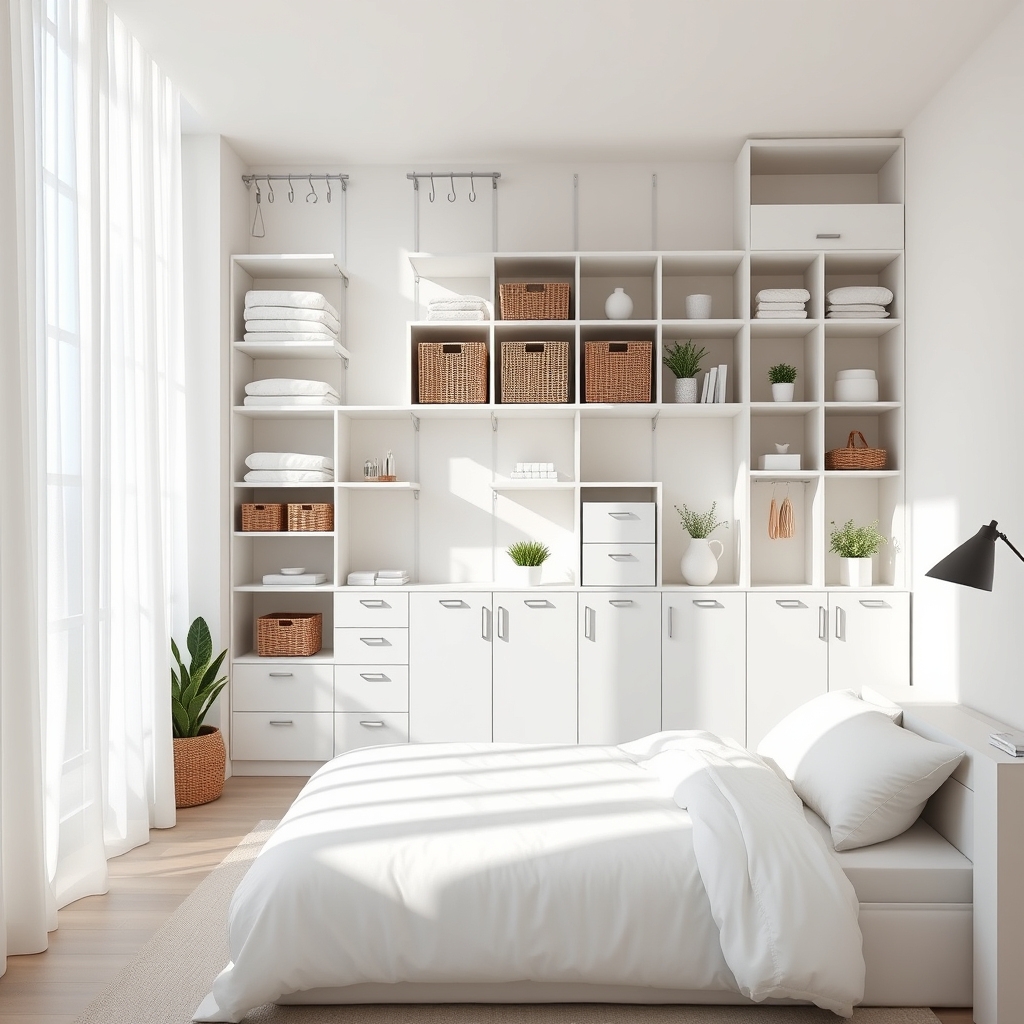
Making the most of vertical wall space is essential in modern bedrooms where floor space comes at a premium. Vertical organization systems transform unused wall areas into functional storage zones, effectively doubling or tripling your storage capacity without consuming valuable floor space.
Proper vertical wall organization not only maximizes storage but also creates an aesthetically pleasing display that can enhance your room’s overall design. When implemented correctly, these systems keep frequently used items within easy reach while storing less-used items higher up, creating an efficient and logical flow to your space.
Required Items:
- Wall anchors and screws
- Stud finder
- Level
- Measuring tape
- Drill
- Pencil
- Wall-mounted shelving units
- Hanging organizers
- Storage hooks
- Pegboard or grid system
- Storage bins or baskets
- Cable ties or velcro straps
Start by mapping out your wall space using a measuring tape and pencil, marking stud locations with the stud finder. Install the main framework of your vertical system, whether it’s adjustable tracks, floating shelves, or a pegboard system, ensuring everything is level and securely anchored to wall studs.
Once the foundation is secure, add your chosen storage components, working from top to bottom. Position less frequently used items at higher levels, daily-use items at eye level, and heavier items closer to the floor for stability.
For maximum efficiency, group similar items together and use clear containers or labels to maintain organization. Consider incorporating a mix of open and closed storage solutions – hooks for hanging items, shelves for display, and enclosed containers for items that should be hidden from view.
To maintain your vertical organization system’s effectiveness, regularly assess and adjust the layout based on changing needs. Install proper lighting to illuminate all storage areas, and leave some empty space for future additions.
Remember to dust and clean your vertical storage components regularly, and periodically check that all mounted elements remain secure and properly aligned with the wall.
Multi-Purpose Furniture Picks
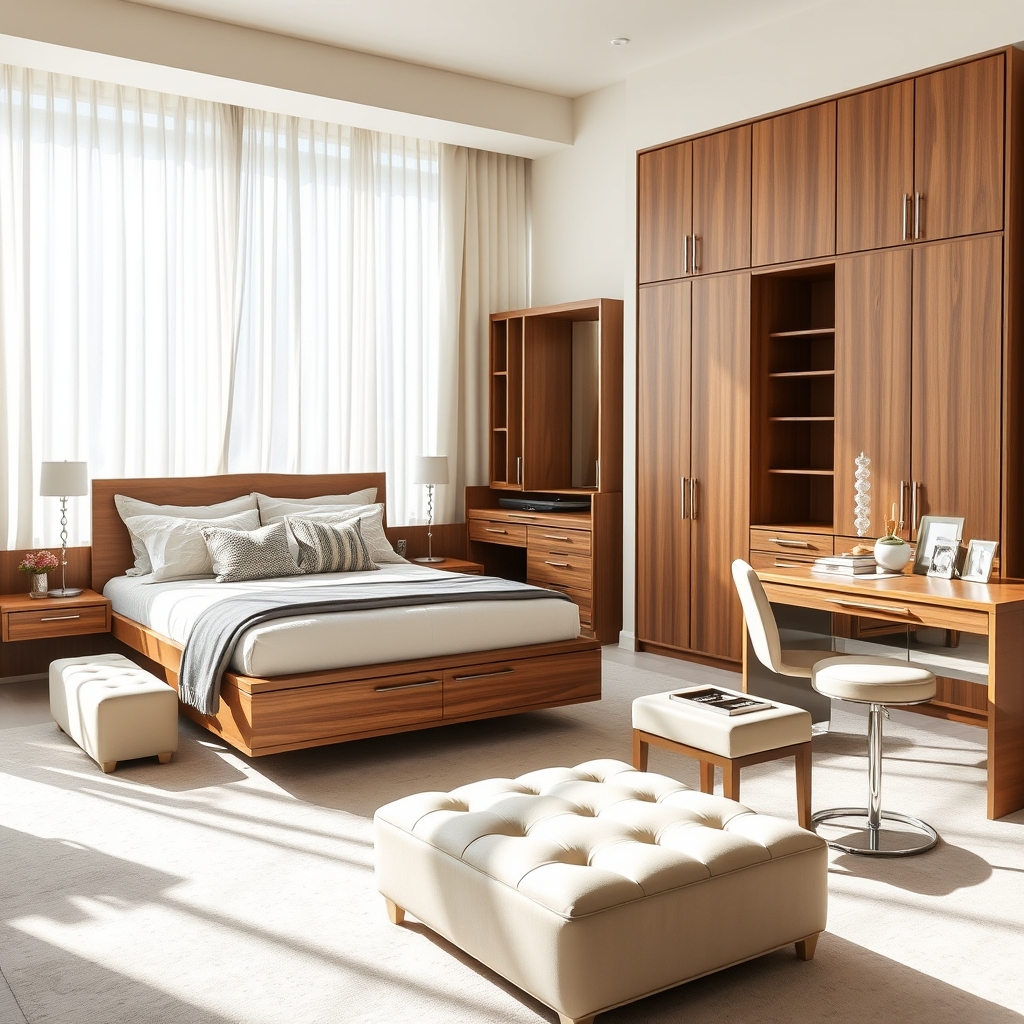
Making the most of multi-purpose furniture in your bedroom is essential for maximizing both space and functionality in today’s often compact living spaces. These versatile pieces serve multiple functions while maintaining style and reducing clutter, allowing you to create a more organized and efficient bedroom environment.
Strategic selection and placement of multi-purpose furniture can effectively double your storage capacity while maintaining the room’s aesthetic appeal. From storage ottomans to bed frames with built-in drawers, these pieces work overtime to keep your belongings organized and easily accessible while serving their primary functions.
Required Items:
- Measuring tape
- Floor plan or room dimensions
- List of storage needs
- Budget worksheet
- Furniture assembly tools
- Level
- Storage containers or organizers
- Labels
- Furniture sliders
- Cleaning supplies
Select multi-purpose furniture pieces based on your specific needs and available space. Start by measuring your room and identifying key areas where dual-function furniture could work best. Focus on pieces like storage beds, bench seating with hidden compartments, or desk-dresser combinations that maximize vertical space.
Consider the weight capacity and durability of each piece, ensuring it can handle both its primary function and storage demands.
When arranging multi-purpose furniture, create clear zones within your bedroom for different activities while maintaining easy access to stored items. Position larger pieces against walls to maximize floor space, and ensure furniture with drawers or compartments has adequate clearance to open fully.
Group complementary items together, such as placing a storage ottoman near a reading nook or positioning a desk-dresser combo in a designated work area.
Additional optimization tips: Regularly assess the contents of your multi-purpose furniture to prevent overcrowding and maintain organization. Use drawer dividers or small containers within larger storage spaces to keep items separated and easily accessible.
Consider seasonal rotation of stored items to maximize space efficiency, and always leave some extra storage capacity for future needs.
Hidden Storage Headboards
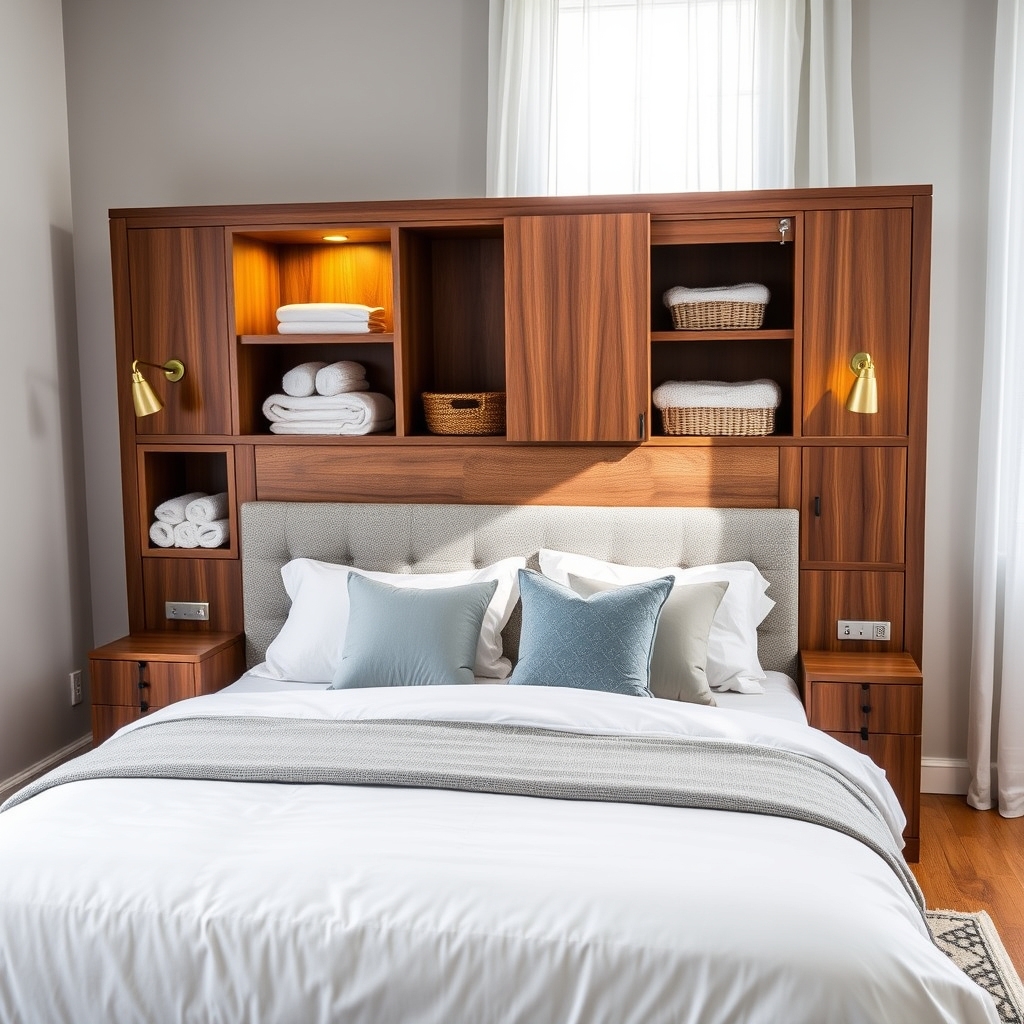
Making the most of your bedroom space starts with utilizing often-overlooked areas, and the headboard presents an excellent opportunity for hidden storage solutions. A well-organized storage headboard can house essential items while maintaining a clean, uncluttered bedroom aesthetic.
Storage headboards offer a practical solution for small bedrooms or spaces where traditional storage furniture won’t fit. By maximizing this vertical space, you can store books, electronics, personal items, and bedding essentials within arm’s reach while eliminating the need for additional furniture pieces.
Required Items:
- Storage bins or baskets
- Drawer organizers
- Clear containers
- Labels
- Measuring tape
- Dust cloths
- Small hooks
- LED strip lights (optional)
- Drawer liners
- Storage dividers
The organization process begins with emptying all compartments and measuring each space to determine appropriate storage solutions. Sort items into categories: frequently used items should go in easily accessible compartments, while seasonal or rarely used items can occupy harder-to-reach spaces.
Install drawer liners to protect the interior surfaces and prevent items from sliding. Use clear containers or labeled bins to separate different categories of items, ensuring everything has a designated spot.
For optimal organization, dedicate specific compartments to different purposes. The top shelf might house current reading materials and electronics, while deeper drawers can store extra bedding or seasonal clothing.
Consider installing small hooks inside doors for hanging lightweight items like sleep masks or charging cables. If your headboard includes display shelving, maintain a minimalist approach to prevent visual clutter.
Maximize organization success by implementing a regular maintenance schedule. Every three months, reassess the contents, remove unused items, and wipe down all surfaces.
Consider adding LED strip lighting to illuminate dark corners, making it easier to locate items. Always keep frequently used items at eye level or within easy reach to maintain the practical benefits of your organized storage headboard.
Corner Space Optimization
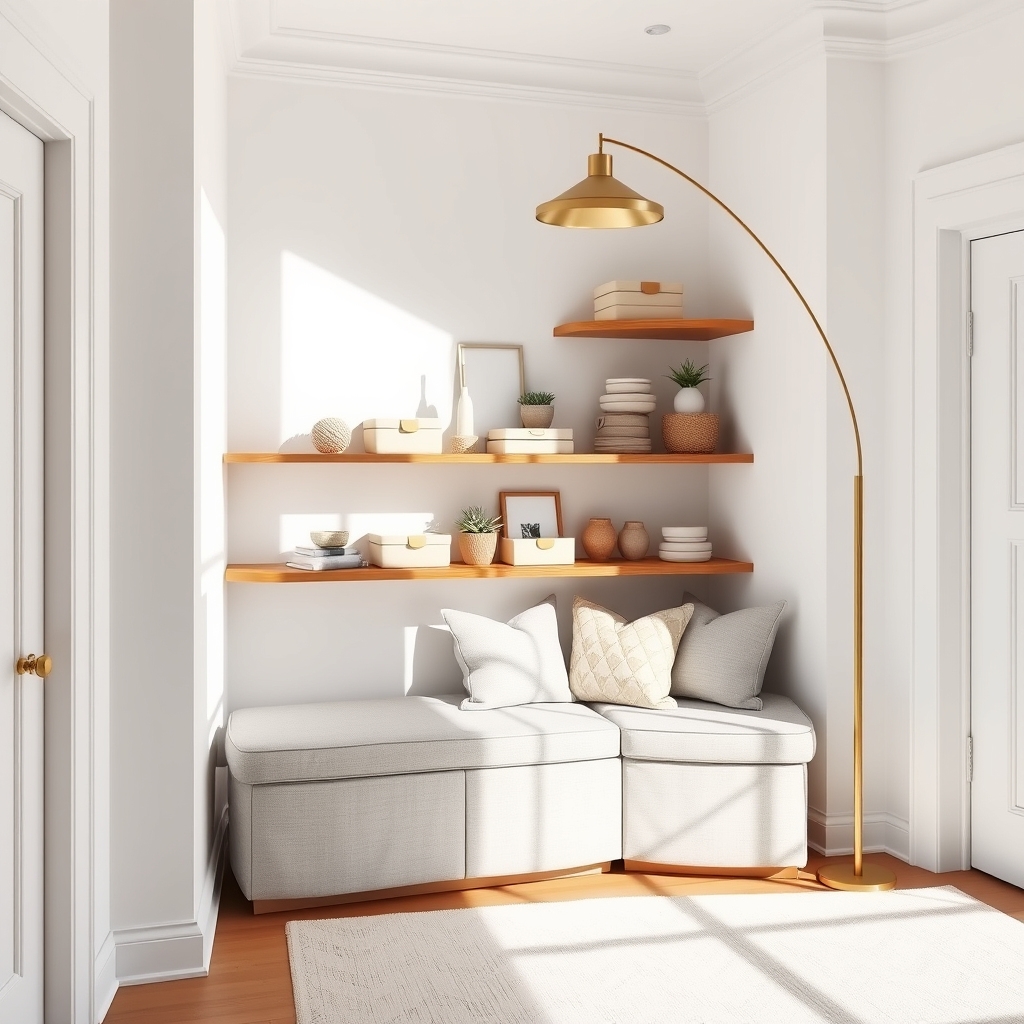
Corner spaces often become neglected dead zones in bedrooms, collecting dust and wasting valuable square footage. These awkward angles actually represent prime organizational opportunities that, when properly utilized, can dramatically increase a room’s storage capacity while maintaining its aesthetic appeal.
Making the most of corner spaces is particularly crucial in smaller bedrooms where every inch counts. Corner optimization can transform these traditionally unused areas into functional storage solutions that work seamlessly with your room’s layout, creating a more organized and spacious-feeling environment.
Required Items:
- Measuring tape
- Level
- Corner shelving units
- Corner desk (optional)
- Floating corner shelves
- Wall anchors and screws
- Power drill
- Corner storage bench (optional)
- Corner clothing rack
- Storage baskets or bins
Start by thoroughly measuring your corner space, including height and width on both walls, noting any baseboards or ceiling moldings that might affect installation. Clear the corner completely and clean the area.
Install your chosen corner storage solution, working from bottom to top if using vertical storage units. For floating shelves, mark and drill pilot holes, ensuring proper spacing between levels.
When arranging items in your corner space, place frequently used items at eye level and arm’s reach. Position heavier items on lower shelves or inside corner storage benches. Utilize storage baskets on shelves to contain smaller items and maintain a clean appearance.
If installing a corner clothing rack, arrange clothes by category and color for both functionality and visual appeal.
Additional Success Tips: Consider incorporating LED strip lighting to illuminate dark corners and make stored items more accessible. Use clear storage containers to easily identify contents, and implement a regular maintenance schedule to prevent corner spaces from becoming cluttered catch-alls.
Label everything clearly and rotate seasonal items to maintain organization throughout the year.
Over-the-Door Storage Hacks
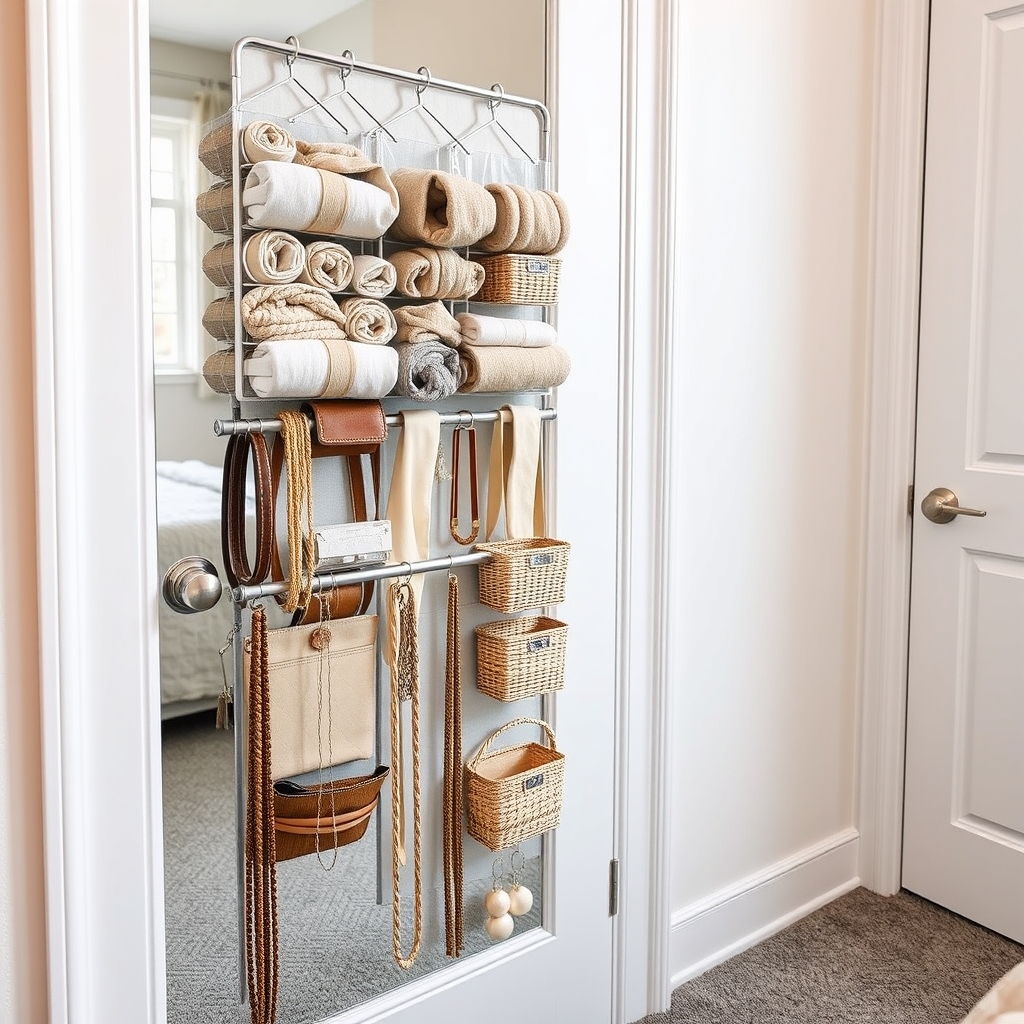
Making the most of vertical space is crucial in any bedroom, and the often-overlooked door surface presents a perfect opportunity for additional storage. Over-the-door storage solutions can transform an unused surface into valuable organizing real estate, helping to declutter your floor space and maintain a tidy bedroom environment.
Over-the-door storage systems are particularly effective for items you need regular access to, such as accessories, shoes, or daily essentials. This organization method not only maximizes space efficiency but also keeps items visible and easily accessible, eliminating the frustration of searching through drawers or bins.
Required Items:
- Over-the-door hanging rack or organizer
- Door hooks (various sizes)
- Clear pocket organizers
- Measuring tape
- Level
- Screwdriver
- Command strips or mounting hardware
- Storage bins or baskets (if needed)
- Labels
- Cable ties
Start by measuring your door’s dimensions and choosing appropriate over-the-door storage solutions that fit without interfering with door operation. Install the main organizing system, ensuring it’s level and secure.
For pocket organizers, arrange them at comfortable reaching height, with frequently used items at eye level. Group similar items together – designate specific pockets or hooks for categories like accessories, beauty products, or small clothing items.
When arranging items, distribute weight evenly across the organizing system to prevent strain on the door. Use clear pockets for visibility and easy access to contents. For heavier items, ensure the organizing system is properly reinforced and secured to the door.
Consider using additional command hooks on the sides of the door for items that need individual hanging space.
Additional Tips: Rotate seasonal items to maintain organization efficiency, and regularly assess the contents to prevent overloading. Use labels to maintain your system and make it easier for family members to follow.
Consider using coordinating containers or bins within the organizers to create a cohesive look while maximizing space. Clean and inspect the organizing systems monthly to ensure they remain secure and functional.
Built-In Wardrobe Strategies
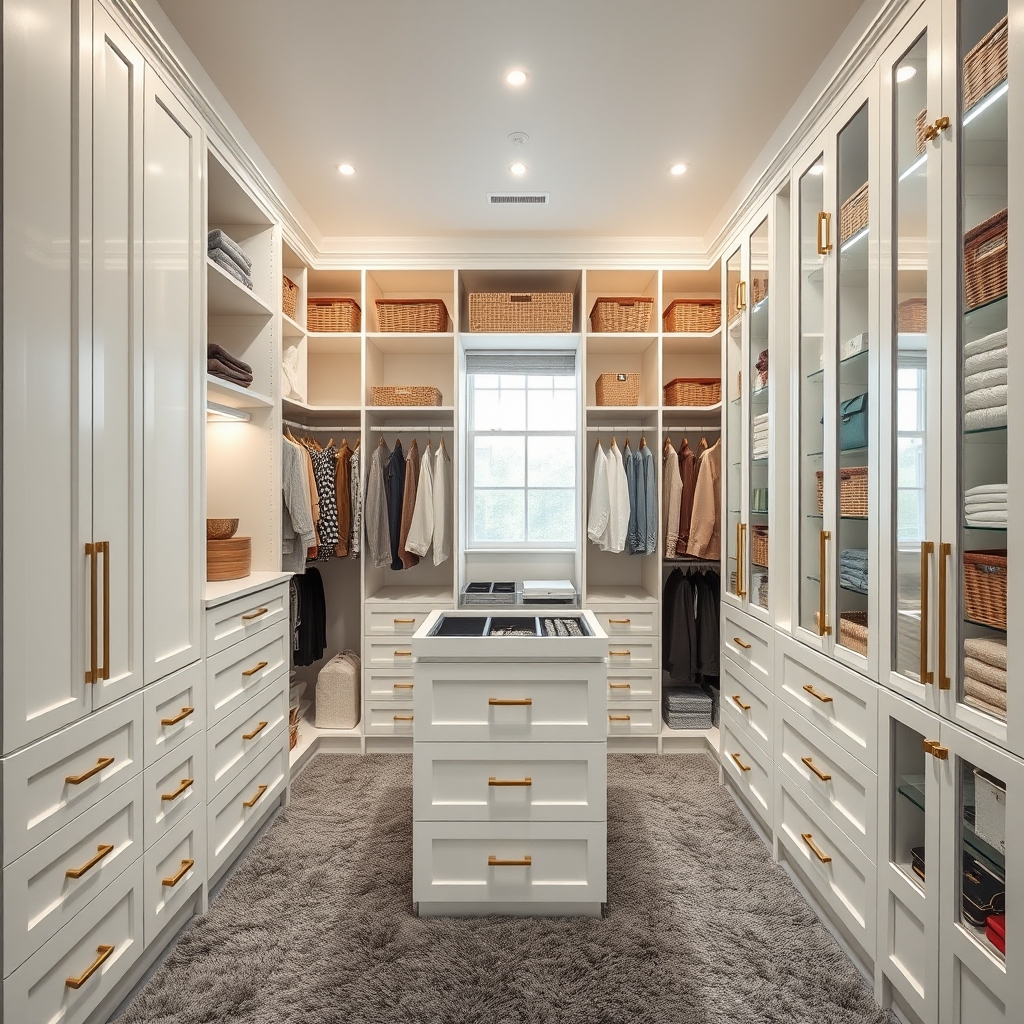
A well-organized built-in wardrobe serves as the cornerstone of an efficient bedroom storage system. Unlike standalone closets, built-in wardrobes maximize vertical space and can be customized to fit specific storage needs, making them invaluable for maintaining order in any bedroom.
Proper organization of a built-in wardrobe not only saves time during daily routines but also preserves the condition of clothing and accessories. Strategic arrangement of items based on frequency of use and seasonal rotation ensures that every inch of space works effectively, turning a potentially cluttered area into a functional storage solution.
Required Items:
- Hanging rod dividers
- Storage boxes
- Drawer organizers
- Shelf dividers
- Labels
- Hangers (uniform style)
- Clear storage containers
- Drawer liners
- Measuring tape
- Storage hooks
Start by removing all items from the wardrobe and categorizing them by type (clothing, accessories, shoes). Install drawer organizers and shelf dividers according to your predetermined categories. Position frequently used items at eye level, with seasonal items stored in higher or lower spaces. Implement a zone system: designate specific areas for formal wear, casual clothes, accessories, and shoes.
For clothing organization, arrange items by category and color, using matching hangers to maintain uniformity. Install hooks on empty wall space for belts, scarves, or bags. Utilize clear storage containers for smaller items and label everything clearly. Place drawer liners in each compartment to protect items and maintain cleanliness.
Maximize organization success by implementing a one-in-one-out rule for new purchases, regularly reviewing contents every three months, and maintaining categorical zones strictly. Consider installing motion-sensor lights for dark corners and using space-saving hangers to increase capacity while maintaining organization.
Floating Shelf Configurations
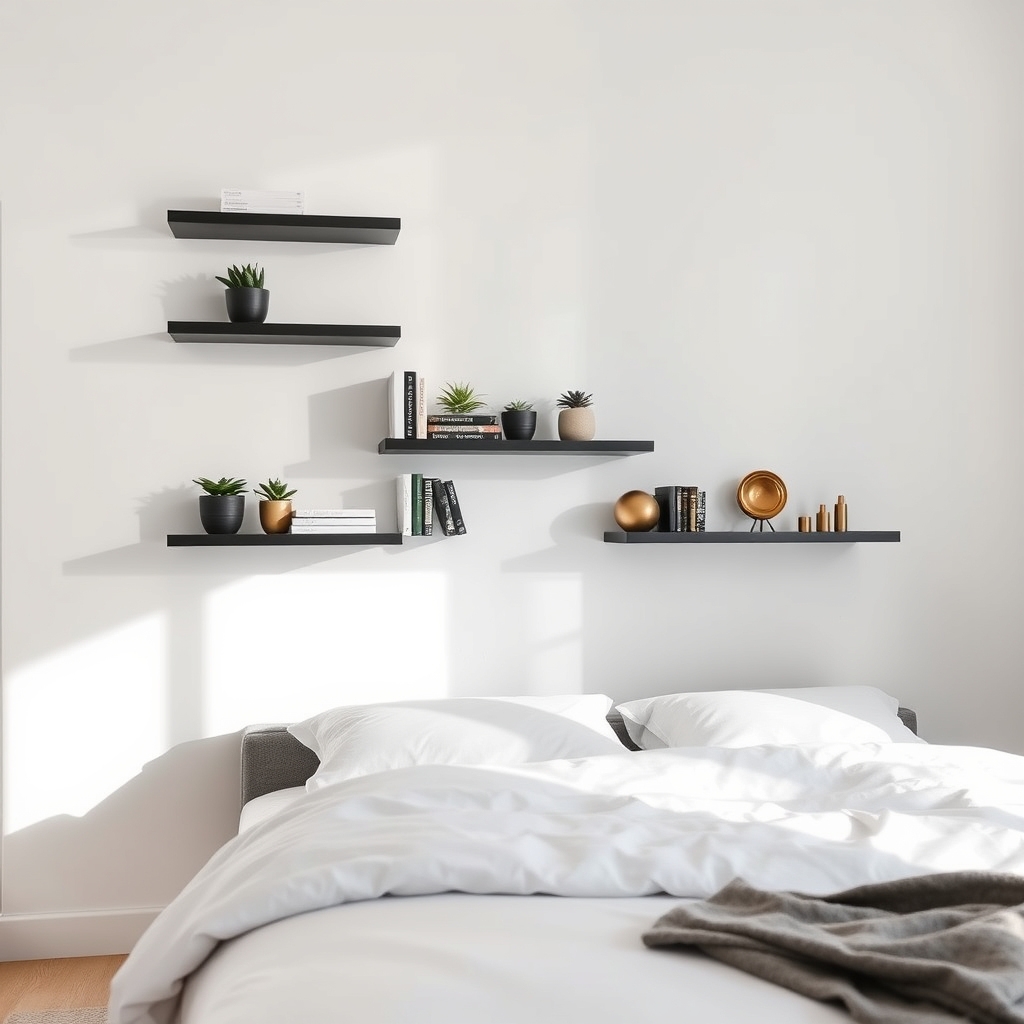
Floating shelves represent one of the most versatile and space-efficient storage solutions for modern bedrooms. These wall-mounted units eliminate the need for bulky furniture while creating an aesthetically pleasing display that maximizes vertical space. When properly configured, floating shelves can transform dead wall space into functional storage areas for books, decorative items, and everyday essentials.
Strategic placement and thoughtful arrangement of floating shelves can dramatically impact both the functionality and visual appeal of your bedroom. By creating deliberate groupings and maintaining proper spacing between shelves, you can establish an organized system that serves multiple purposes while maintaining a clean, uncluttered appearance.
Required Items:
- Stud finder
- Level
- Measuring tape
- Pencil
- Drill and drill bits
- Wall anchors
- Screwdriver
- Floating shelves
- Wall brackets
- Safety goggles
- Cleaning cloth
Start by mapping out your shelf configuration on the wall using a pencil and level, ensuring proper spacing between units. Locate wall studs using a stud finder and mark their positions clearly. Install the first shelf bracket at your desired height, ensuring it’s perfectly level and properly secured into studs or using appropriate wall anchors.
Continue installing additional brackets, maintaining consistent spacing and alignment. For optimal organization, arrange shelves in purposeful groupings based on intended use. Consider creating zones for different categories: decorative items at eye level, frequently accessed items within easy reach, and less-used items on higher shelves.
Maintain at least 12 inches of vertical space between shelves to accommodate various item heights and create visual breathing room. To maximize the effectiveness of your floating shelf configuration, incorporate storage solutions like decorative boxes or baskets to contain smaller items.
Group similar items together, and maintain a balance between functional storage and aesthetic appeal by leaving some open space for visual interest. Regular dusting and periodic reorganization will help maintain the functionality and appearance of your floating shelf system.

